硝基多环芳烃(nitrated polycyclic aromatic hydrocarbons, NPAHs)是一类重要的多环芳烃(polycyclic aromatic hdrocarbons, PAHs)衍生物, 已被公认为有毒空气污染物[1~5].NPAHs在大气中的浓度一般比母体PAHs低1~2数量级[6~8], 但部分NPAHs的致突变性和致癌性比PAHs更强[9, 10], 因而引起了持续地关注.NPAHs在环境中污染广泛, 在所有环境介质和食物中均有检出, 并且可以在生物体内积累[11~14].此外还发现NPAHs具有持久性, 在远离排放源的南极大气颗粒物中也有检出[15~17].大气中NPAHs的来源主要为一次排放和二次生成, 一次排放的NPAHs来自生物质和化石燃料的不完全燃烧, 二次生成的NPAHs主要由PAHs与大气中的· OH、· NO3和O3等氧化剂发生光化学反应生成[18~21].
粤港澳大湾区(Guangdong-Hong Kong-Macao Greater Bay Area, GBA)是中国经济活力最强和人口最多的区域之一, 在国家发展大局中具有重要战略地位, 但过去的快速发展导致了较严重的大气污染问题[22~24].粤港澳大湾区监测数据表明, 近年来O3浓度呈现增高趋势并成为首要大气污染物, 导致区域性大气光化学反应的发生[25, 26].在粤港澳大湾区高温和高紫外线强度的气象条件下, 有利于大气光化学反应发生, 促成PAHs向NPAHs转化, 对当地居民造成一定的潜在健康风险.
目前还缺乏对大气中NPAHs的区域性分析, 且研究介质主要集中在大气颗粒物, 对大气气相NPAHs的报道相对较少.本研究同时采集了粤港澳大湾区大气气相和颗粒相中的NPAHs, 使用气相色谱-三重四极杆串联质谱检测NPAHs的浓度水平, 分析NPAHs的气粒分布特征, 识别NPAHs的主要来源, 评估呼吸致癌风险, 以期为政府部门管控粤港澳大湾区大气污染提供数据支撑.
1 材料与方法 1.1 仪器、试剂与材料大流量采样器为MEGA X1(Hornet, 美国), 石英纤维滤膜为90 mm×90 mm(Whatman, 英国), XAD-2树脂为20~60目(Sigma, 美国), 聚氨酯泡沫(polyurethane foam, PUF)为50 mm×90 mm(Tisch, 美国), 气相色谱-三重四极杆串联质谱为Trace 1310-TSQ 9000(Thermo, 美国), 旋转蒸发仪为R100(Buchi, 瑞士), 氮吹浓缩仪为MG-2200(Eyela, 日本), 索氏提取装置为500 mL(欣维尔, 中国); 色谱柱为Rxi-dioxin(60 m×0.25 mm×0.25 μm, Restek, 美国).
正己烷为色谱纯(Honeywell, 美国), 二氯甲烷为色谱纯(Honeywell, 美国). 18种NPAHs标准品均购自Accustandard(美国), 9种氘代NPAHs标准品均购自Accustandard(美国)和Chiron(挪威).
1.2 点位布设和样品采集本研究选取粤港澳大湾区覆盖的广州、深圳、珠海、东莞、佛山、中山、惠州、江门和肇庆等九市, 参照文献[27]布设点位(n=22), 如图 1所示.每个点位冬、夏季各采集一个样品, 冬季采样时间为2019年12月2~7日, 夏季采样时间为2020年8月12~28日.采用进口大流量采样器以250 L ·min-1的流量持续24 h采集样品, 使用石英纤维滤膜采集悬浮态颗粒相中NPAHs, 使用XAD-2树脂和PUF吸附气相中的NPAHs.
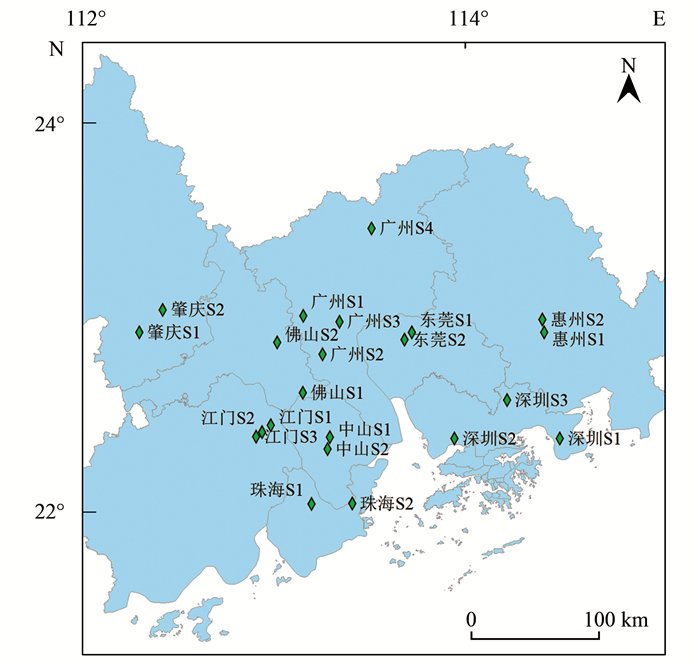
|
图 1 采样点位示意 Fig. 1 Schematic of sampling site location |
索氏抽提器和500 mL平底烧瓶用二氯甲烷索氏抽提4 h.抽提完成后, 将抽提装置中二氯甲烷移除并自然晾干, 待用.将滤膜单独放入索氏提取器, 将玻璃采样筒中的PUF和树脂用镊子分离, 分别单独放入另外两个索氏抽提器中. 3个索氏提取器均添加20 ng提取内标(9种氘代NPAHs), 使用正己烷+二氯甲烷(1+1)连续抽提24 h, 抽提结束后将抽提器中的溶剂完全转移至平底烧瓶, 并旋转蒸发浓缩至约2 mL, 转换溶剂为正己烷浓缩至约1 mL, 备份样品.由于部分NPAHs容易在前处理过程中降解或者光解, 因此不对样品进行净化, 样品浓缩至约200 μL, 添加20 ng进样内标(氘代芘), 上机测试.
1.4 仪器分析 1.4.1 色谱条件采用Rxi-dioxin(60 m×0.25 mm×0.25 μm)色谱柱对NPAHs进行分离.色谱柱升温程序: 初温70℃, 保持2 min, 以25℃ ·min-1升至200℃, 保持1 min, 再以2.5℃ ·min-1升温至265℃后, 保持10 min, 以25℃ ·min-1升至320℃, 保持16 min.进样口温度280℃, 采用不分流进样, 进样量为1 μL.
1.4.2 质谱条件传输线温度300℃, 增强型离子源(AEI源)温度300℃, 扫描方式为选择反应离子扫描(selected reaction monitoring, SRM)模式, 每个单体的定量离子对与碰撞能量由仪器自动优化获得, 相关参数见表 1.
|
|
表 1 NPAHs的保留时间、定量离子对和碰撞能量 Table 1 Retention time, quantitative ion pairs, and collision energy for each NPAHs |
1.5 质量保证/质量控制(QA/QC)
每批样品至少准备一个运输空白和实验室空白, 以判断采样运输过程和实验室分析过程的污染状况.每批样品至少准备一个空白加标, 以判断实验室分析过程的准确度和精密度是否符合要求.质控结果: 所有NPAHs的运输空白和实验室空白均小于检出限, 空白加标回收率范围为103% ~129%. NPAHs的检出限范围为5~62 pg(以10倍信噪比为检出限).
2 结果与讨论 2.1 采样方法与检测方法已有研究中广泛报道的大气中NPAHs采样方法是使用滤膜采集颗粒物中的NPAHs, 使用PUF吸附气态NPAHs.考虑到环境空气中PAHs的采集需要同时使用滤膜、PUF和XAD-2树脂[28], 本研究使用了类似方法采集大气中的NPAHs.结果表明: 树脂中∑18NPAHs占大气中∑18NPAHs的比例较高, 夏季占比40.9%, 冬季占比37.0%; 树脂中低分子量NPAHs的占比则更高, 比如1-NNap占比为: 树脂(64.9%)>PUF(34.4%)>滤膜(0.8%).这表明树脂是采集大气中NPAHs的必要采样介质之一, 但尚未发现使用树脂采集大气NPAHs的报道.本研究首次提出了同时使用滤膜、PUF和XAD-2树脂采集大气中NPAHs的方法, 以准确表征环境空气中NPAHs的污染状况.
文献[18, 29]中NPAHs的检测仪器通常是气相色谱-质谱联用仪配备负化学离子源, 或高效液相色谱配备紫外或荧光检测器.负化学离子源检测NPAHs时有很好地灵敏度(检出限pg级水平), 但选择性不高, 易造成假阳性干扰.高效液相色谱检测NPAHs可避免部分NPAHs单体在高温下降解, 但在分离某些同分异构体时存在困难.如2-NFlt和3-NFlt, 二者在大气中的污染来源不同, 若检测时无法区分, 可能误导后续的数据分析工作.
本研究采用气相色谱-三重四极杆串联质谱联用仪作为检测仪器, 其优点主要在于: SRM模式下信噪比非常理想, 检出限(5~62 pg)可满足大气样品超痕量NPAHs的检测需求; SRM模式下的选择性非常好, 可有效排除假阳性干扰.实验表明, 本研究中所有大气样品完成萃取和浓缩后, 无需净化可直接上机检测, 从而避免光敏NPAHs单体[30]的损失.此外, 由于2-NFlt和3-NFlt在气相色谱柱上难以分离, 已有研究中通常用2+3-NFlt替代2-NFlt[6, 31~33], 也有研究另用一根专用色谱柱分离2-NFlt和3-NFlt[7, 34].本研究实现了一根气相色谱柱同时检测18种NPAHs并分离2-NFlt和3-NFlt, 如图 2所示, 在SRM模式下2-NFlt和3-NFlt的分离度较好.

|
图 2 2-NFlt和3-NFlt的色谱图 Fig. 2 Chromatogram of 2-NFlt and 3-NFlt |
本研究中的18中NPAHs单体, 除了3-NFlt、6-NChr和6-NBaP, 其余15种NPAHs均有检出(见表 2和表 3).在夏冬两季检出率均为100%的NPAHs有9种, 检出率高于70%的NPAHs数量占据总数的72%, 说明NPAHs普遍存在于粤港澳大湾区的环境空气中.
|
|
表 2 夏季大气中NPAHs的检出浓度1)/pg ·m-3 Table 2 Detection concentration of NPAHs in summer atmospheric samples/pg ·m-3 |
|
|
表 3 冬季大气中NPAHs的检出浓度1)/pg ·m-3 Table 3 Detection concentration of NPAHs in winter atmospheric samples/pg ·m-3 |
22个研究点位环境空气中ρ(∑18NPAHs)范围: 162~2 094 pg ·m-3, 检出浓度最高的单体依次为: 1-NNap[(229±148)pg ·m-3]、2-NNap[(152±108)pg ·m-3]、9-NAnt[(109±68)pg ·m-3]和2-NFlt[(74±59)pg ·m-3].有9种NPAHs的平均浓度小于10 pg ·m-3.本研究中1-NNap和2-NNap的浓度占∑18NPAHs的56.7%, 说明粤港澳大湾区环境空气中的NPAHs以两种硝基萘为主.
夏季和冬季平均ρ(∑18NPAHs)分别为(675±430)pg ·m-3和(637±349)pg ·m-3, 夏季略高于冬季. 15种检出的NPAHs单体中, 除了3-NBip、2-NFlt、1-NPyr和7NBaA, 其余NPAHs单体在夏季的平均浓度均高于冬季. 22个研究点位夏季浓度最低点为深圳S1, 浓度最高点为广州S3; 冬季浓度最低点为广州S4, 浓度最高点为东莞S1.NPAHs在夏季和冬季的族谱特征见图 3, 1-NNap和2-NNap在夏季和冬季的总占比分别为62%和53%, 9-NAnt在夏季和冬季的占比均为16%, 2-NFlt在夏季和冬季占比分别为9%和14%; 1-NNap、2-NNap、9-NAnt和2-NFlt 4种主要NPAHs单体在夏季和冬季的总占比分别为87%和83%.NPAHs在夏季和冬季的族谱特征大致相同, 可能是因为NPAHs在夏季和冬季的来源贡献相似.
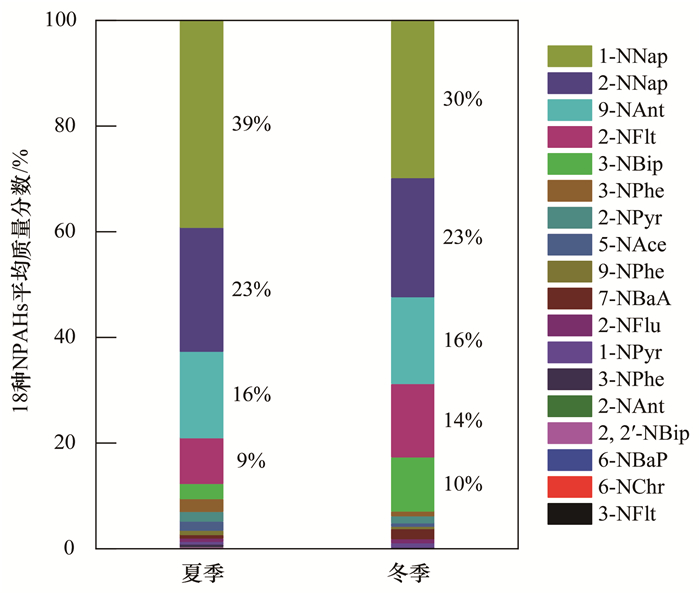
|
图 3 粤港澳大湾区大气中NPAHs的族谱特征 Fig. 3 Congener profile characteristics of NPAHs in the atmosphere of GBA |
筛选近年来同时报道颗粒相和气相中NPAHs的研究进行比较发现(见表 4), 同其他研究结果相比, 本研究中检测的1-NNap和2-NNap处于较高的污染水平, 而其余NPAHs单体处于较低的污染水平.与已有报道的珠三角某地区空气中NPAHs浓度相比[7], 1-NNap、2-NNap、5-NAce和9-NPhe基本处于同一水平.而已有报道的西安市地区空气中极高的NPAHs污染水平[33], 反映了当地复杂的NPAHs污染来源, 包括各种工业源、机动车排放和光化学反应源.而本研究的采样点位远离工业区或交通繁忙区域, 这也可能是本研究区域环境空气中多种NPAHs浓度较低的原因.
|
|
表 4 粤港澳大湾区大气中NPAHs浓度的比较与国内外城市对比1)/pg ·m-3 Table 4 Concentration comparison of NPAHs in ambient air at GBA with available data for NPAHs domestically and overseas/pg ·m-3 |
2.3 NPAHs的气/粒分配
NPAHs在不同采样材料中的平均浓度见表 5, 可以发现: 2环和3环NPAHs倾向于赋存在气相, 4环NPAHs倾向于吸附在颗粒相.其中1-NNap和2-NNap在树脂中的浓度最高, 1-NPyr、2-NPyr和7-NBaA在滤膜中的浓度最高, 其余单体在PUF中的浓度最高.
|
|
表 5 NPAHs在滤膜、PUF和树脂中的浓度/pg ·m-3 Table 5 Concentration of NPAHs in filters, PUF, and resin/pg ·m-3 |
颗粒相NPAHs占大气总NPAHs(气相+颗粒相)的比例, 随着NPAHs分子量的增大而增大(如图 4).对比冬季和夏季的Logistic拟合曲线发现, 冬季和夏季的颗粒相NPAHs占比存在显著差异(P=0.005), 冬季NPAHs更倾向于吸附在颗粒相中, 而夏季NPAHs则更倾向于赋存在气相中, 显然是由于不同季节的气温变化导致的, 以往研究中也报道了类似的现象[1, 33].影响NPAHs在气相和颗粒相中分配的因素有很多, 除了其本身的理化性质和气象条件外, 固体颗粒物的粒径、有机碳的比例、含水率、NPAHs的来源等, 都会显著影响这种气/粒分配[1, 8, 40].
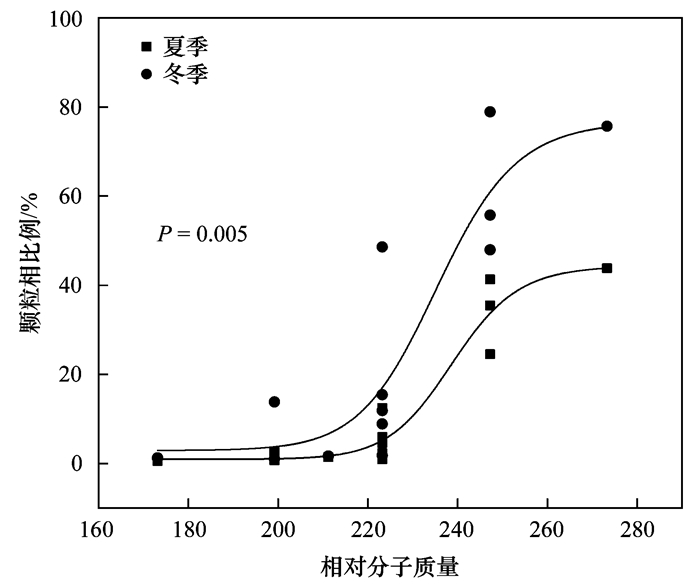
|
P值为夏季和冬季NPAHs配对样本T检验的显著水平 图 4 颗粒相NPAHs占大气总NPAHs的比例 Fig. 4 Fraction of NPAHs concentrations in the particulate fraction of their total atmospheric concentrations |
2-NFlt是NPAHs二次生成的标志物, 1-NPyr是NPAHs一次排放的标志物, 已有研究中通常使用2-NFlt/1-NPyr的浓度比值判断大气中NPAHs的来源类别.若比值大于5, 则表明NPAHs的主要来源是光化学反应二次生成; 若比值小于5, 则表明NPAHs的主要来源是燃烧源一次排放[41, 42].图 5展示了22个点位冬季和夏季的2-NFlt/1-NPyr比值, 44个样品中有43个样品的比值大于5, 说明二次生成是粤港澳大湾区夏季和冬季大气中NPAHs的主要来源. 2-NFlt/1-NPyr在夏季和冬季的均值分别为19.6±12.7和19.4±14.2, 季节差异很小, 而大部分研究中报道的比值通常夏季大于冬季.分析可能的原因是: 粤港澳大湾区没有冬季供暖需求, 一次排放贡献的NPAHs不存在明显季节性差异.
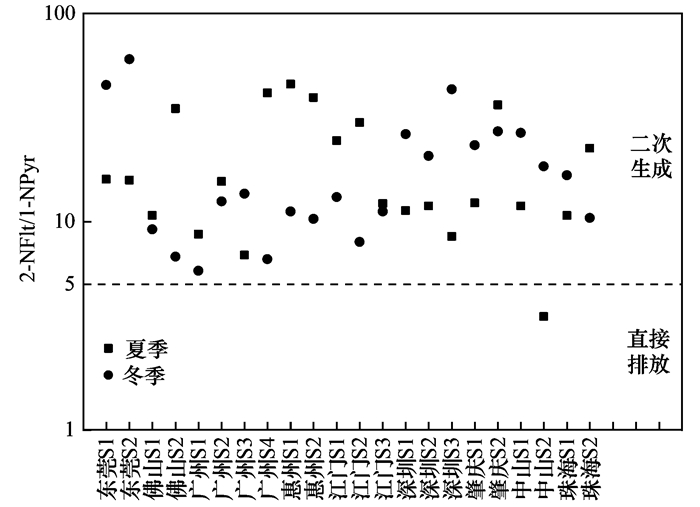
|
图 5 2-NFlt与1-NPyr的浓度比值特征 Fig. 5 Ratio characteristics of concentrations of 2-NFlt and 1-NPyr |
2-NFlt主要来自荧蒽与· OH(白天)和· NO3(夜晚)反应所生成, 而2-NPyr则只能来自芘与· OH在白天反应生成.因此2-NFlt/2-NPyr的浓度比值可以用于识别大气中NPAHs的二次生成源, 当该比值小于10时, 二次生成源以· OH反应生成的贡献为主, 而当该比值大于100时, 二次生成源以· NO3反应生成的贡献为主[41, 42].图 6展示了22个点位冬季和夏季的2-NFlt/2-NPyr比值, 44个样品中有31个样品的比值小于10, 说明研究区域大气中二次生成的NPAHs以· OH反应生成的贡献为主.
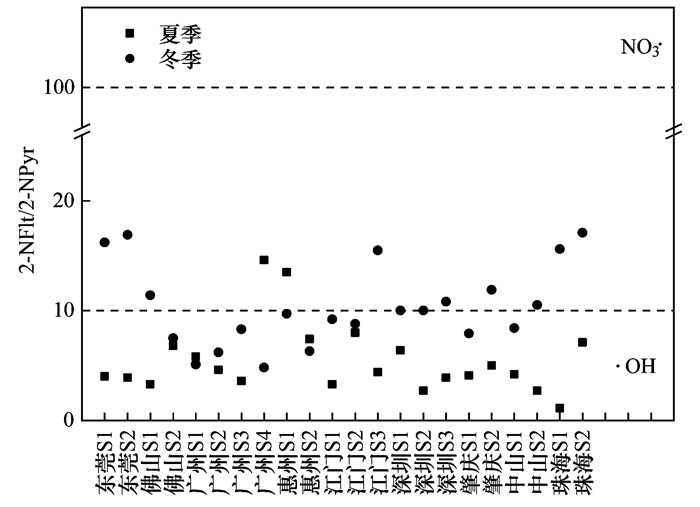
|
图 6 2-NFlt与2-NPyr的浓度比值特征 Fig. 6 Ratio characteristics of concentrations of 2-NFlt and 2-NPyr |
本研究采用美国环保局推荐的污染物致癌健康风险评估模型, 对NPAHs的呼吸暴露风险进行评价.污染物日均呼吸暴露剂量ADDinh计算公式如下:

|
式中, c为空气中污染物浓度, mg ·m-3; IR为呼吸速率, m3 ·d-1; EF为暴露频率, d ·a-1; ED为暴露持续时间, a; BW为体重, kg; AT为平均暴露时间, a.本研究的成人呼吸暴露参数选用文献[43]中的平均值, 儿童暴露参数选用6岁儿童的暴露参数[44], 见表 6.
|
|
表 6 成人与儿童的呼吸暴露参数 Table 6 Inhalation exposure parameters of adults and children |
污染物呼吸暴露致癌风险评估模型公式如下:

|
式中, Rinh为呼吸暴露致癌风险, 无量纲; SFinh为呼吸致癌斜率因子, kg ·d ·mg-1; ADDinh为污染物日均呼吸暴露剂量, mg ·(kg ·d)-1.依据美国环保署的致癌风险参考限值: 当Rinh<10-6时, 风险可忽略; 当Rinh介于10-6~10-4时, 风险可接受; 当Rinh>10-4时, 具备致癌风险.
本研究涉及的18种目标NPAHs的呼吸致癌斜率因子SFinh数据, 通过查阅加州环境健康危害评估办公室(California Office of Environmental Health Hazard Assessment, OEHHA)的数据库[45]获得, 具体见表 7.
|
|
表 7 NPAHs呼吸致癌斜率因子 Table 7 Cancer slope factors of NPAHs through inhalation |
图 7为粤港澳大湾区成人和儿童的NPAHs呼吸暴露致癌风险值, 夏季平均风险值(成人2.85×10-7±2.41×10-7, 儿童5.02×10-7±3.87×10-7)高于冬季(成人2.25×10-7±1.04×10-7, 儿童2.66×10-7±1.10×10-7), 22点位儿童的NPAHs呼吸暴露致癌风险值均高于成人.在夏季, 惠州S1儿童、广州S1成人和儿童的NPAHs呼吸致癌风险Rinh介于10-6~10-4, 风险可接受; 其余所有点位的Rinh<10-6, 风险可忽略.在冬季, 所有点位的Rinh<10-6, 风险均可忽略.说明粤港澳大湾区人群的呼吸暴露致癌风险可控.但由于本研究并未覆盖所有的NPAHs, 如二硝基多环芳烃, 大气中的NPAHs致癌风险可能被低估.
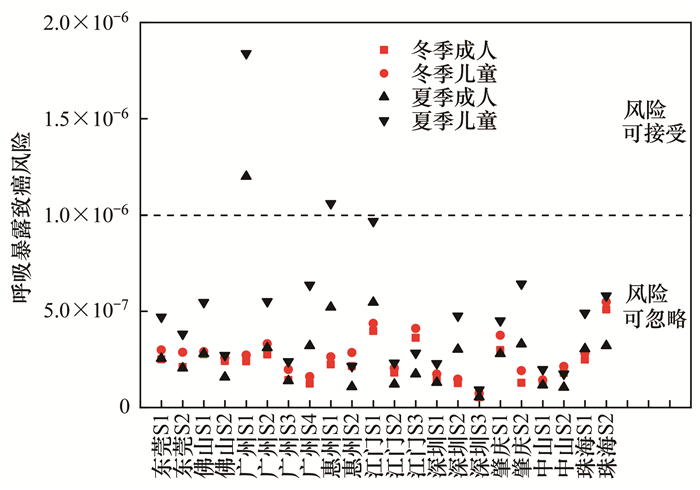
|
图 7 成人和儿童的NPAHs呼吸暴露致癌风险值 Fig. 7 Carcinogenic risk values for NPAHs of adults and children |
(1) 同时使用滤膜、PUF和XAD-2树脂, 可以更高效采集到气态和颗粒态的NPAHs, 准确表征环境空气中NPAHs的污染状况.
(2) NPAHs普遍存在于粤港澳大湾区的环境空气中, 以1-NNap、2-NNap、9-NAnt和2-NFlt为主, 夏季和冬季的族谱特征相似.
(3) 颗粒相NPAHs占大气总NPAHs的比例, 随分子量的增大而增大; 冬季NPAHs倾向于吸附在颗粒相中, 而夏季NPAHs更倾向于赋存在气相中.
(4) 粤港澳大湾区大气中NPAHs在夏季和冬季的主要来源是二次生成, 二次生成源以· OH反应生成的贡献为主.
(5) 粤港澳大湾区大气NPAHs在夏季的呼吸致癌平均风险值高于冬季, 粤港澳大湾区人群的呼吸暴露致癌风险可控.
| [1] | Albinet A, Leoz-Garziandia E, Budzinski H, et al. Nitrated and oxygenated derivatives of polycyclic aromatic hydrocarbons in the ambient air of two French alpine valleys: part 1:concentrations, sources and gas/particle partitioning[J]. Atmospheric Environment, 2008, 42(1): 43-54. DOI:10.1016/j.atmosenv.2007.10.009 |
| [2] | Benbrahim-Tallaa L, Baan R A, Grosse Y, et al. Carcinogenicity of diesel-engine and gasoline-engine exhausts and some nitroarenes[J]. The Lancet Oncology, 2012, 13(7): 663-664. DOI:10.1016/S1470-2045(12)70280-2 |
| [3] | Kawanaka Y, Matsumoto E, Wang N, et al. Contribution of nitrated polycyclic aromatic hydrocarbons to the mutagenicity of ultrafine particles in the roadside atmosphere[J]. Atmospheric Environment, 2008, 42(32): 7423-7428. DOI:10.1016/j.atmosenv.2008.06.032 |
| [4] |
刘攀亮, 剧媛丽, 毛潇萱, 等. 宁东能源化工基地大气PM2.5中硝基多环芳烃污染特征及呼吸暴露风险[J]. 环境科学, 2019, 40(6): 2556-2564. Liu P L, Ju Y L, Mao X X, et al. Pollution characteristics and risk assessment of nitro polycyclic aromatic hydrocarbons in PM2.5 of Nanjing, China[J]. Environmental Science, 2019, 40(6): 2556-2564. |
| [5] |
傅银银, 文浩哲, 王向华, 等. 南京市大气细颗粒物(PM2.5)中硝基多环芳烃污染特征与风险评估[J]. 环境科学, 2021, 42(6): 2626-2633. Fu Y Y, Wen H Z, Wang X H, et al. Pollution characteristics and risk assessment of nitro polycyclic aromatic hydrocarbons in PM2.5 of Nanjing, China[J]. Environmental Science, 2021, 42(6): 2626-2633. |
| [6] | Wei S L, Huang B, Liu M, et al. Characterization of PM2.5-bound nitrated and oxygenated PAHs in two industrial sites of South China[J]. Atmospheric Research, 2012, 109-110: 76-83. DOI:10.1016/j.atmosres.2012.01.009 |
| [7] | Huang B, Liu M, Bi X H, et al. Phase distribution, sources and risk assessment of PAHs, NPAHs and OPAHs in a rural site of Pearl River Delta region, China[J]. Atmospheric Pollution Research, 2014, 5(2): 210-218. DOI:10.5094/APR.2014.026 |
| [8] | Tomaz S, Shahpoury P, Jaffrezo J L, et al. One-year study of polycyclic aromatic compounds at an urban site in Grenoble (France): seasonal variations, gas/particle partitioning and cancer risk estimation[J]. Science of the Total Environment, 2016, 565: 1071-1083. DOI:10.1016/j.scitotenv.2016.05.137 |
| [9] | Durant J L, Busby W F Jr, Lafleur A L, et al. Human cell mutagenicity of oxygenated, nitrated and unsubstituted polycyclic aromatic hydrocarbons associated with urban aerosols[J]. Mutation Research/Genetic Toxicology, 1996, 371(3-4): 123-157. DOI:10.1016/S0165-1218(96)90103-2 |
| [10] | Misaki K, Takamura-Enya T, Ogawa H, et al. Tumour-promoting activity of polycyclic aromatic hydrocarbons and their oxygenated or nitrated derivatives[J]. Mutagenesis, 2016, 31(2): 205-213. DOI:10.1093/mutage/gev076 |
| [11] | Hung C H, Ho H P, Lin M T, et al. Purge-assisted headspace solid-phase microextraction combined with gas chromatography/mass spectrometry for the determination of trace nitrated polycyclic aromatic hydrocarbons in aqueous samples[J]. Journal of Chromatography A, 2012, 1265: 1-6. DOI:10.1016/j.chroma.2012.09.084 |
| [12] | Chen Y C, Shen G F, Su S, et al. Contamination and distribution of parent, nitrated, and oxygenated polycyclic aromatic hydrocarbons in smoked meat[J]. Environmental Science and Pollution Research, 2014, 21(19): 11521-11530. DOI:10.1007/s11356-014-3129-8 |
| [13] | Deng K L, Wong T Y, Wang Y N, et al. Combination of precolumn nitro-reduction and ultraperformance liquid chromatography with fluorescence detection for the sensitive quantification of 1-nitronaphthalene, 2-nitrofluorene, and 1-nitropyrene in meat products[J]. Journal of Agricultural and Food Chemistry, 2015, 63(12): 3161-3167. DOI:10.1021/acs.jafc.5b00523 |
| [14] | Uno S, Tanaka H, Miki S, et al. Bioaccumulation of nitroarenes in bivalves at Osaka Bay, Japan[J]. Marine Pollution Bulletin, 2011, 63(5-12): 477-481. DOI:10.1016/j.marpolbul.2011.02.044 |
| [15] | Hayakawa K. Environmental behaviors and toxicities of polycyclic aromatic hydrocarbons and nitropolycyclic aromatic hydrocarbons[J]. Chemical and Pharmaceutical Bulletin, 2016, 64(2): 83-94. DOI:10.1248/cpb.c15-00801 |
| [16] | Lafontaine S, Schrlau J, Butler J, et al. Relative influence of trans-Pacific and regional atmospheric transport of PAHs in the Pacific Northwest, US[J]. Environmental Science & Technology, 2015, 49(23): 13807-13816. |
| [17] | Tang N, Sato K, Tokuda T, et al. Factors affecting atmospheric 1-, 2-nitropyrenes and 2-nitrofluoranthene in winter at Noto peninsula, a remote background site, Japan[J]. Chemosphere, 2014, 107: 324-330. DOI:10.1016/j.chemosphere.2013.12.077 |
| [18] | Bandowe B A M, Meusel H. Nitrated polycyclic aromatic hydrocarbons (nitro-PAHs) in the environment-a review[J]. Science of the Total Environment, 2017, 581-582: 237-257. DOI:10.1016/j.scitotenv.2016.12.115 |
| [19] | Dimashki M, Harrad S, Harrison R M. Measurements of nitro-PAH in the atmospheres of two cities[J]. Atmospheric Environment, 2000, 34(15): 2459-2469. DOI:10.1016/S1352-2310(99)00417-3 |
| [20] | Titaley I A, Walden D M, Dorn S E, et al. Evaluating computational and structural approaches to predict transformation products of polycyclic aromatic hydrocarbons[J]. Environmental Science & Technology, 2019, 53(3): 1595-1607. |
| [21] | Yan J P, Wang X P, Gong P, et al. Nitrated polycyclic aromatic compounds in the atmospheric environment: a review[J]. Critical Reviews in Environmental Science and Technology, 2021, 51(11): 1159-1185. DOI:10.1080/10643389.2020.1748486 |
| [22] |
周军芳, 范绍佳, 李浩文, 等. 珠江三角洲快速城市化对环境气象要素的影响[J]. 中国环境科学, 2012, 32(7): 1153-1158. Zhou J F, Fan S J, Li H W, et al. Impact of urbanization on meteorological factors in Pearl River Delta[J]. China Environmental Science, 2012, 32(7): 1153-1158. DOI:10.3969/j.issn.1000-6923.2012.07.001 |
| [23] |
王耀庭, 梁加成, 郑祚芳, 等. 基于地-空观测数据的粤港澳大湾区大气污染调查及时空演变特征[J]. 环境科学, 2020, 41(5): 2075-2086. Wang Y T, Liang J C, Zheng Z F, et al. Characteristics of spatial and temporal evolution and investigation of air pollution in Guangdong-Hong Kong-Macao Greater Bay Area based on ground-space observation data[J]. Environmental Science, 2020, 41(5): 2075-2086. |
| [24] |
刘建, 吴兑, 范绍佳. 珠江三角洲区域污染分布及其垂直风场特征[J]. 环境科学, 2015, 36(11): 3989-3998. Liu J, Wu D, Fan S J. Distribution of regional pollution and the characteristics of vertical wind field in the Pearl River Delta[J]. Environmental Science, 2015, 36(11): 3989-3998. |
| [25] | Wang Y H, Gao W K, Wang S, et al. Contrasting trends of PM2.5 and surface-ozone concentrations in China from 2013 to 2017[J]. National Science Review, 2020, 7(8): 1331-1339. DOI:10.1093/nsr/nwaa032 |
| [26] |
赵伟, 高博, 卢清, 等. 2006~2019年珠三角地区臭氧污染趋势[J]. 环境科学, 2021, 42(1): 97-105. Zhao W, Gao B, Lu Q, et al. Ozone pollution trend in the Pearl River Delta region during 2006-2019[J]. Environmental Science, 2021, 42(1): 97-105. DOI:10.3969/j.issn.1006-4427.2021.01.017 |
| [27] | 环境保护部. 《国家环境空气监测网(地级以上城市)设置方案》[EB/OL]. http://www.mee.gov.cn/gkml/hbb/bwj/201204/t20120401_250935.htm, 2012-04-01. |
| [28] | HJ 646-2013, 环境空气和废气气相和颗粒物中多环芳烃的测定气相色谱-质谱法[S]. |
| [29] | Zhang Y H, Li R J, Fang J, et al. Simultaneous determination of eighteen nitro-polyaromatic hydrocarbons in PM2.5 by atmospheric pressure gas chromatography-tandem mass spectrometry[J]. Chemosphere, 2018, 198: 303-310. DOI:10.1016/j.chemosphere.2018.01.131 |
| [30] | Schlemitz S, Pfannhauser W. Supercritical fluid extraction of mononitrated polycyclic aromatic hydrocarbons from tea-correlation with the PAH concentration[J]. Zeitschrift für Lebensmitteluntersuchung und-Forschung A, 1997, 205(4): 305-310. DOI:10.1007/s002170050170 |
| [31] | Ringuet J, Albinet A, Leoz-Garziandia E, et al. Diurnal/nocturnal concentrations and sources of particulate-bound PAHs, OPAHs and NPAHs at traffic and suburban sites in the region of Paris (France)[J]. Science of the Total Environment, 2012, 437: 297-305. DOI:10.1016/j.scitotenv.2012.07.072 |
| [32] | Wu S P, Yang B Y, Wang X H, et al. Diurnal variation of nitrated polycyclic aromatic hydrocarbons in PM10 at a roadside site in Xiamen, China[J]. Journal of Environmental Sciences, 2012, 24(10): 1767-1776. DOI:10.1016/S1001-0742(11)61018-8 |
| [33] | Wei C, Han Y M, Bandowe B A M, et al. Occurrence, gas/particle partitioning and carcinogenic risk of polycyclic aromatic hydrocarbons and their oxygen and nitrogen containing derivatives in Xi'an, central China[J]. Science of the Total Environment, 2015, 505: 814-822. DOI:10.1016/j.scitotenv.2014.10.054 |
| [34] | Liu D, Lin T, Syed J H, et al. Concentration, source identification, and exposure risk assessment of PM2.5-bound parent PAHs and nitro-PAHs in atmosphere from typical Chinese cities[J]. Scientific Reports, 2017, 7(1). DOI:10.1038/s41598-017-10623-4 |
| [35] | Li W, Wang C, Shen H Z, et al. Concentrations and origins of nitro-polycyclic aromatic hydrocarbons and oxy-polycyclic aromatic hydrocarbons in ambient air in urban and rural areas in northern China[J]. Environmental Pollution, 2015, 197: 156-164. DOI:10.1016/j.envpol.2014.12.019 |
| [36] | Scipioni C, Villanueva F, Pozo K, et al. Preliminary characterization of polycyclic aromatic hydrocarbons, nitrated polycyclic aromatic hydrocarbons and polychlorinated dibenzo-p-dioxins and furans in atmospheric PM10 of an urban and a remote area of Chile[J]. Environmental Technology, 2012, 33(7): 809-820. DOI:10.1080/09593330.2011.597433 |
| [37] | Brorström-Lundén E, Remberger M, Kaj L, et al. Results from the Swedish national screening programme 2008: screening of unintentionally produced organic contaminants[EB/OL]. https://www.ivl.se/webdav/files/Publikationer/B1944.pdf, 2010-10-07. |
| [38] | Barrado A I, García S, Castrillejo Y, et al. Exploratory data analysis of PAH, nitro-PAH and hydroxy-PAH concentrations in atmospheric PM10-bound aerosol particles. Correlations with physical and chemical factors[J]. Atmospheric Environment, 2013, 67: 385-393. DOI:10.1016/j.atmosenv.2012.10.030 |
| [39] | Barrado A I, García S, Sevillano M L, et al. Vapor-phase concentrations of PAHs and their derivatives determined in a large city: correlations with their atmospheric aerosol concentrations[J]. Chemosphere, 2013, 93(9): 1678-1684. DOI:10.1016/j.chemosphere.2013.05.031 |
| [40] | Li W, Shen G F, Yuan C Y, et al. The gas/particle partitioning of nitro- and oxy-polycyclic aromatic hydrocarbons in the atmosphere of northern China[J]. Atmospheric Research, 2016, 172-173: 66-73. DOI:10.1016/j.atmosres.2015.12.008 |
| [41] | Wang W T, Jariyasopit N, Schrlau J, et al. Concentration and photochemistry of PAHs, NPAHs, and OPAHs and toxicity of PM2.5 during the Beijing Olympic Games[J]. Environmental Science & Technology, 2011, 45(16): 6887-6895. |
| [42] | Keyte I J, Harrison R M, Lammel G. Chemical reactivity and long-range transport potential of polycyclic aromatic hydrocarbons-a review[J]. Chemical Society Reviews, 2013, 42(24): 9333-9391. DOI:10.1039/c3cs60147a |
| [43] |
环境保护部. 中国人群暴露参数手册(成人卷)[M]. 北京: 中国环境出版社, 2013. Ministry of Environmental Protection. Exposure factors handbook of Chinese population (adults)[M]. Beijing: China Environmental Science Press, 2013. |
| [44] |
刘军, 赵金平, 杨立辉, 等. 南方典型生活垃圾焚烧设施环境呼吸暴露风险评估[J]. 生态环境学报, 2016, 25(3): 440-446. Liu J, Zhao J P, Yang L H, et al. Inhalation exposure risk assessment of a typical municipal solid waste incinerator, south China[J]. Ecology and Environmental Sciences, 2016, 25(3): 440-446. |
| [45] | OEHHA. Appendix a: hot spots unit risk and cancer potency values[EB/OL]. https://oehha.ca.gov/media/downloads/crnr/appendixa.pdf, 2020-10-16. |
 2022, Vol. 43
2022, Vol. 43


